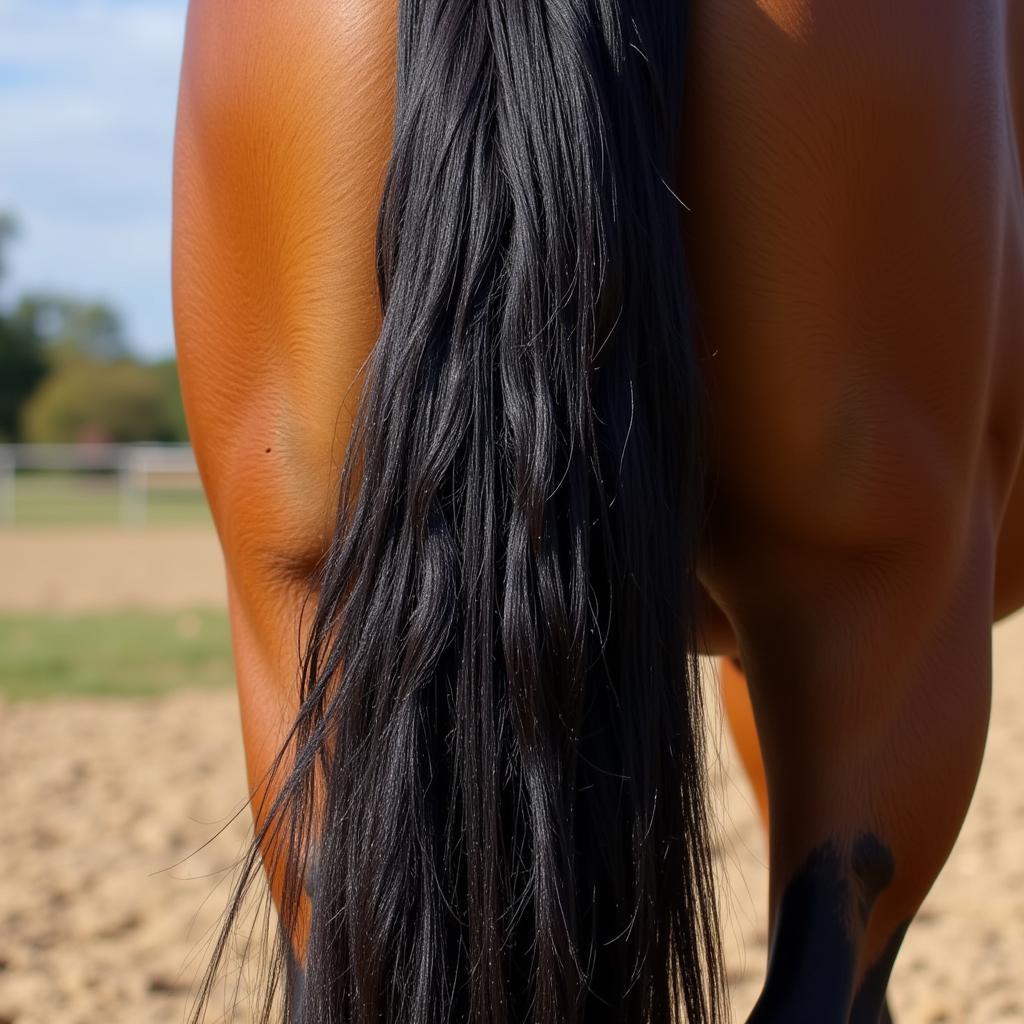A horse’s tail is much more than just long, flowing hair. It’s a vital tool for communication, fly control, and balance. Understanding the anatomy, care, and common issues related to a horse’s tail is crucial for any horse owner.
The horse’s tail plays a significant role in its overall well-being. From swatting away pesky flies to signaling their mood, this appendage is essential. Let’s delve deeper into the world of the horse’s tail, covering everything from its structure and function to common problems and proper care techniques.
Anatomy and Function of a Horse’s Tail
The tail begins at the end of the vertebral column, extending beyond the bony structure with a complex arrangement of muscles, tendons, and ligaments. These allow for a surprising range of movement, enabling the horse to use its tail for various purposes. The long hairs that cascade down from the dock are what we typically associate with the horse’s tail. These hairs grow from the tailbone and are primarily composed of keratin, the same protein that makes up human hair and fingernails.
Communication Through Tail Movement
Horses are masters of non-verbal communication, and their tails play a crucial role. A swishing tail can indicate irritation or the presence of flies. A clamped down tail might suggest fear or pain, while a slightly raised tail can be a sign of alertness or excitement. Understanding these subtle cues is essential for building a strong bond with your horse.
The Importance of the Tail for Balance and Fly Control
Beyond communication, the horse’s tail serves important practical functions. The tail acts as a counterbalance, helping the horse maintain its equilibrium, especially during movement. And, of course, it’s a highly effective fly swatter, protecting the horse from irritating insects.
Caring for Your Horse’s Tail
Proper care of the horse’s tail is essential for maintaining its health and appearance. Regular grooming helps prevent tangles and removes dirt and debris. Avoid over-washing, which can strip the natural oils and lead to dryness. horse oil non silicone shampoo can be a great option for maintaining a healthy, shiny tail.
Grooming Techniques for a Healthy Horse’s Tail
When grooming, use a wide-toothed comb or brush specifically designed for horse tails. Start at the bottom and work your way up, gently teasing out any knots. Avoid pulling or yanking, which can damage the hair and even cause the tail to break.
Common Tail Problems and Solutions
Several issues can affect a horse’s tail, including breakage, hair loss, and fungal infections. If you notice any unusual changes in your horse’s tail, consult a veterinarian to determine the cause and appropriate treatment. Sometimes, dietary deficiencies can also contribute to a dull or unhealthy tail. Supplements like immune support for horses can help ensure your horse is receiving the necessary nutrients for optimal tail health.
Why is my horse rubbing its tail?
A rubbing tail can be caused by various factors, from dry skin and insect bites to more serious issues like parasites or allergies. Identifying the root cause is essential for effective treatment.
What does a healthy horse’s tail look like?
A healthy horse’s tail is typically thick, shiny, and free of tangles and breakage. It should move freely and be used effectively for communication and fly control.
 Healthy Horse Tail Appearance
Healthy Horse Tail Appearance
“A well-maintained tail is a sign of a well-cared-for horse,” says Dr. Emily Carter, Equine Veterinarian. “Regular grooming and attention to any changes can help prevent problems and keep your horse comfortable.”
Conclusion
The horse’s tail is a multifaceted appendage that plays a vital role in communication, balance, and fly control. Understanding its function and providing proper care are essential for every horse owner. By following these guidelines, you can help ensure your horse’s tail remains healthy, beautiful, and functional for years to come. Remember, a healthy tail contributes to a happy horse! Certain grasses like foxtail grass and horses can also cause irritation, so be mindful of your horse’s grazing environment. You might also be interested in learning about horse hair tail extensions for showing.
FAQ
- How often should I groom my horse’s tail?
- What kind of brush should I use on my horse’s tail?
- What can cause a horse’s tail to break?
- How can I treat a fungal infection in my horse’s tail?
- What are the signs of a healthy horse’s tail?
- How can I prevent my horse from rubbing its tail?
- Can diet affect the health of my horse’s tail?
“Nutrition plays a significant role in tail health,” adds Sarah Miller, Certified Equine Nutritionist. “A balanced diet is crucial for healthy hair growth.” For growing horses, you might want to explore options like purina growth horse feed.
Need help with your horse’s care? Contact us! Phone: 0772127271, Email: [email protected] or visit us at QGM2+WX2, Vị Trung, Vị Thuỷ, Hậu Giang, Việt Nam. We have a 24/7 customer service team.